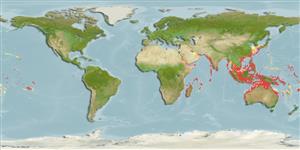Common names from other countries
Environment: milieu / climate zone / depth range / distribution range
Ecologia
; estuarina; intervalo de profundidade 0 - 80 m (Ref. 125642). Tropical; 36°N - 31°S, 30°E - 135°W
Indo-Pacific. From East Africa to French Polynesia, north to Japan and south to Australia. Tropical to temperate.
Length at first maturity / Tamanho / Peso / Idade
Maturity: Lm 8.3, range 8 - ? cm Max length : 20.0 cm CW macho/indeterminado; (Ref. 343); 21.5 cm CW (female); Idade máx. registada: 3.00 anos (Ref. 128174)
Carapace finely granulose, regions just discernible; 9 teeth on each anterolateral margin, the last tooth 2 to 3 times larger than preceding teeth. Chelae elongated in males; larger chela with conical tooth at base of fingers; pollex ridged. Color: olive to dark green, with 3 prominent maroon to red spots on posterior 1/3 of carapace. Easily distinguished from other species by its very distinct color markings.
Maximum length (female) from Ref. 119750. Occurs from the intertidal zone (especially juveniles) to depths of 30 m (Ref. 343). Subtidal (Ref. 106854). Inhabits sandy to sandy-muddy substrates (Refs. 343, 106287, 125338), in bays and estuaries (Ref. 106287). Also in brackish water (Ref. 801). Subtropical and tropical climates (Ref. 343). Mainly a predator of sessile and slow-moving benthic macroinvertebrates (Ref. 102720); may be a scavenger (Ref. 100855). Omnivore (Ref. 116259).
Members of the order Decapoda are mostly gonochoric. Mating behavior: Precopulatory courtship ritual is common (through olfactory and tactile cues); usually indirect sperm transfer.
Ng, P.K.L. 1998. (Ref. 343)
Status na Lista Vermelha da IUCN (Ref. 130435)
Status no CITES (Ref. 108899)
Not Evaluated
Not Evaluated
Uso pelos humanos
Pescarias: espécies comerciais
| FishSource | Sea Around Us
Ferramentas
Fontes da internet
Estimates based on models
Preferred temperature
(Ref.
115969): 18.3 - 29, mean 27.5 (based on 1552 cells).
Resiliência
Elevada, tempo mínimo de duplicação da população menor que 15 meses (K=0.82-1.9; tm=0.65; tmax=3).
Vulnerabilidade
Low vulnerability (10 of 100).
